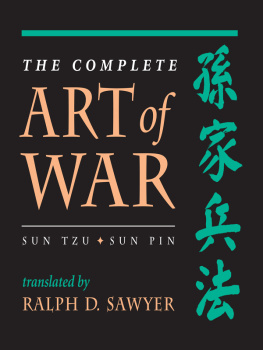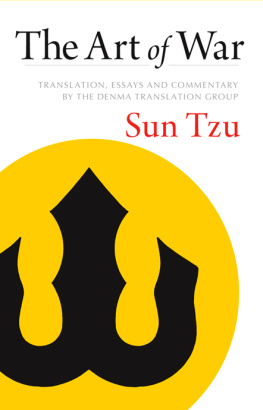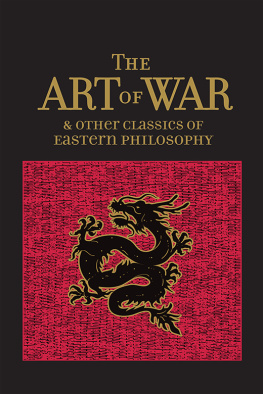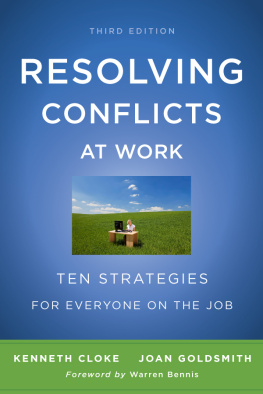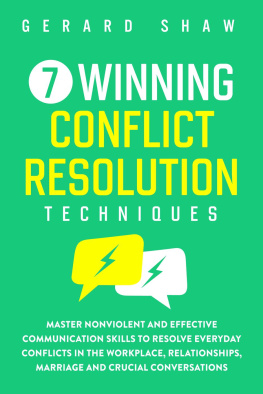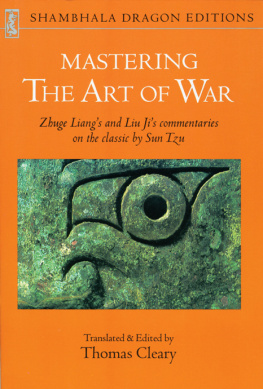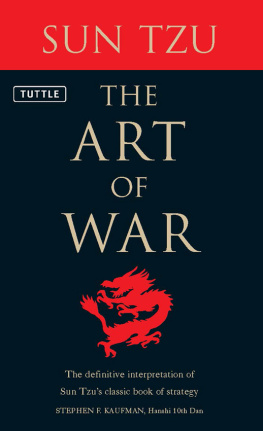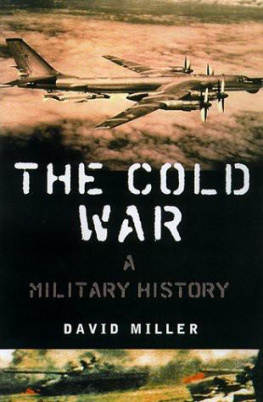

To my daughter, Victoria, and nephew, Dustinand all childrenwho will lead the world and set it right.
The Art of WarSpirituality for Conflict: Annotated & Explained
2009 Quality Paperback Edition, Second Printing
2008 Quality Paperback Edition, First Printing
Annotation and introductory material 2008 by Thomas Huynh
Foreword 2008 by Marc Benioff
Preface 2008 by Thomas Cleary
All rights reserved. No part of this book may be reproduced or transmitted in any form or by any means, electronic or mechanical, including photocopying, recording, or by any information storage and retrieval system, without permission in writing from the publisher.
For information regarding permission to reprint material from this book, please mail or fax your request in writing to SkyLight Paths Publishing, Permissions Department, at the address / fax number listed below, or e-mail your request to permissions@skylightpaths.com.
Library of Congress Cataloging-in-Publication Data
Huynh, Thomas. The art of warspirituality for conflict : annotated & explained / annotations by Thomas Huynh.
p. cm.
Includes bibliographical references.
ISBN-13: 978-1-59473-244-7
ISBN-10: 1-59473-244-2
1. PeaceReligious aspects. 2. Conflict managementReligious aspects. 3. Sunzi, 6th cent. B.C. Sunzi bing fa. 4. Military art and science. 5. Strategy. I. Title.
BL65.P4H89 2008
355.02dc22 2007052942
10 9 8 7 6 5 4 3 2
Manufactured in the United States of America
Cover design: Walter C. Bumford III
Cover art: istockphoto.com/grahamnorris
SkyLight Paths Publishing is creating a place where people of different spiritual traditions come together for challenge and inspiration, a place where we can help each other understand the mystery that lies at the heart of our existence.
SkyLight Paths sees both believers and seekers as a community that increasingly transcends traditional boundaries of religion and denominationpeople wanting to learn from each other, walking together, finding the way.
SkyLight Paths, Walking Together, Finding the Way and colophon are trademarks of LongHill Partners, Inc., registered in the U.S. Patent and Trademark Office.
Walking Together, Finding the Way
Published by SkyLight Paths Publishing
A Division of LongHill Partners, Inc.
Sunset Farm Offices, Route 4, P.O. Box 237
Woodstock, VT 05091
Tel: (802) 457-4000 Fax: (802) 457-4004
www.skylightpaths.com
Contents
Foreword
by Marc Benioff
As the chairman and CEO of a technology company, I am always thinking about the future. Its somewhat ironic then, that the philosophies and strategies I use to manage salesforce.com were written on slips of bamboo 2,500 years ago.
Larry Ellison, the CEO of Oracle Corporation and my mentor, first introduced me to The Art of War, the Chinese military treatise by Sun Tzu, when I was an executive at Oracle. Fundamentally, the book demonstrates how small armies can defeat larger ones. Larry applied its principles to business with enthusiasm, and in growing Oracle from a small start-up into one of the worlds leading software companies, he proved the enduring effectiveness of its insights even in modern circumstances. Sun Tzus treatise was originally written as a guide for generals in ancient China, but I was amazed by its ability to transcend time and its relevance to leaders of any mission.
So what does an age-old book about warfare and combat have to do with business or personal interactions? A whole lot, it turns out. As Thomas Huynh poignantly illustrates in The Art of WarSpirituality for Conflict: Annotated & Explained , Sun Tzu may have been a general, but he wasnt a warmonger. He was a leader defined by compassion and spirituality, and he possessed a desire for resolution. The Art of War isnt about war so much as it is about the art of winning .
Sun Tzus original intention, as Huynh explains in the following pages, was to teach a disadvantaged person or persons how to shift the balance of power. Essentially, the book reveals how David can topple Goliath. Since I first read The Art of War more than a dozen years ago, I have applied its concepts to many areas of my life. The tenets of the book provided me with the confidence to enter an industry dominated by much bigger playersand gave us the strategies to render them powerless. Ultimately, it is how salesforce.com took on the entire software industry.
I started salesforce.com in 1999 with an idea to make purchasing and using notoriously onerous business software as simple as using a website like Yahoo! or Amazon.com. At first, we didnt have much more than a good idea. We launched the company in a one-bedroom rented apartment. Our servers were housed in a walk-in closet, our conference room was a balcony, and as we grew, the overflow went into my own apartment next door. (We hung Ethernet cable through the redwood trees to connect the two offices.) We had no real office, no revenues, and no profits. We didnt even have a marketat that time, there were no phrases like On-Demand or Software as a Service to describe what we did.
We had very little compared to our competitors, but it didnt matter. (As Sun Tzu noted, having more resources does not ensure advantage.) What we lacked in terms of accepted ideas and impressive infrastructure, we made up for in energy and passion. We toiled away under pictures of the Dalai Lama and Albert Einstein. From my studies of Sun Tzu, I had learned both the importance of instilling inspiration and how to turn that vision into a reality: in Sun Tzus own words, One who knows how to unite upper and lower ranks in purpose will be victorious. I found the way to unite our army was to pursue an objective of great meaning that was accessible to the masses. We found that purpose with our End of Software mission. We were not just selling a Customer Relationship Management (CRM) tool, a service that would enable salespeople to sell more effectivelywe were changing the way the software industry worked. We were committed to using the Internet to make software easier to use, less expensive, and more successful for our customers. We were evangelizing important valuesdemocratizing an industry and embracing the way of the future.
Evoking innovation as inspiration was important, but there was another effort that was also a great unifier. To be truly successful, companies need to have a purpose bigger than making a profit. We created an integrated philanthropic model that gives 1 percent of our equity, 1 percent of our profits, and 1 percent of our employees time to local and global nonprofit organizations. The Salesforce Foundation opened its first after-school technology center in San Francisco in July 2000 and has since created more than sixty technology centers and media programs in twelve countries where we have offices, including Japan, Ireland, and Singapore. The Foundation has also made meaningful contributions to disaster relief efforts in the United States and abroad. All of this was accomplished by the more than seventy thousand hours donated by our two thousand employees who embraced this effort with enthusiasm. By giving employees paid time off to volunteer, we have also seen a secondary gain. With an opportunity to do more than change the way businesses manage and share information, our employees have a greater sense of personal pride and satisfactionand they are happier and therefore more productive at work.
While there have been modern critics of compassionate capitalism, Sun Tzu understood that being practical and being compassionate are not mutually exclusive. In fact, it is self-serving to be compassionate, he said, for preserving a defeated army intact helps quell resentmentand ease later interactions. Weve found this wisdom to be true. How can we thrive as a company if the community we operate in falters? We cant: many of our employees, partners, customers, and shareholders come from the communities the Foundation serves. We need to ensure that our local community succeeds for us to succeed and we need to ensure that our global community thrives for us to grow. Acting in a way that is both practical and compassionate has proved to be a secret weapon for success.
Next page

